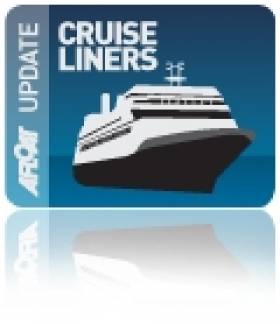Displaying items by tag: Solsticeclass
A First for Cobh as Two Cruise Giants Come and Go
In an unprecedented scheduling of cruiseships to the Port of Cork (Cobh), the inbound Independence of the Seas (154,407 tonnes) the largest cruiseship to call to any Irish port, passed the 122,000 tonnes Celebrity Eclipse which was preparing to depart from the town's cruise terminal.
Some 15 minutes later Celebrity Eclipse pulled away from the berth. During that timeframe the Independence of the Seas had completely turned around in the opposite direction to face Cobh after maneuvering in the swinging basin between Cobh and the Naval Base on Haulbowline Island.
The 4,175-passenger Independence of the Seas is the third of the 'Freedom' class vessels. She has a length of 339m and is a mere 11m shorter in distance to that of the 350m berth at Cobh. The 38m wide cruiseship has a draft of 8.7m and the depth of water at the town's quayside is 9.1m.
The 15-deck vessel was built by Aker Finnyards in Turku, Finland in 2008 for Royal Caribbean International (RCI). Amenities on the Freedom class consist of the an innovative surf park, canitilevered whirlpools, ice-skating rink, full-size boxing ring and a H2O Zone waterpark.
As for the 3,179-passenger Celebrity Eclipse, she is the second of five 'Solstice' class sisters and measures 317m (length) 48m (beam) and draws 8.6m. On the top deck there is the fresh green grass located at Lawn Club. She was built by the Meyer Werft shipyard in Papenburg, Germany and entered service last year for her owners Celebrity Cruises.
Independence of the Seas departed yesterday afternoon on an overnight passage from Southampton where the vessel is based in the summer and for the winter she is based out of Florida. The Celebrity Eclipse departed the UK south coast port from Cobh where the larger cruiseship is also to make overnight port of call.
In total 10,000 passengers and crew will of visited the Cork Harbour region alone over the May Bank holiday. To meet the surge in demand for the shore-based excusions a fleet of buses awaited and additional trains were also laid-on by Irish Rail. The railway station is located next-door to the Cobh Heritage Centre which retraces the town's strong trans-Atlantic liner era.
- Cobh
- Cork Harbour
- port of Cork
- Independence of the Seas
- Ports and Shipping
- Cobh Cruise Terminal
- Ports and Shipping News
- Cork Harbour News
- Irish Rail
- Celebrity Eclipse
- Port of Cork News
- Aker Finnyards
- Celebrity Cruises
- Royal Caribbean International
- Freedomclass
- Solsticeclass
- MeyerWerft
- Cobh Heritage Centre





























































